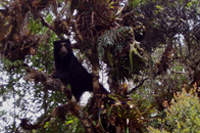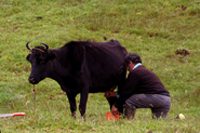Fundación Cordillera Tropical's 'Don Oso' Program aims to reduce retaliatory killing of the endangered Andean bear to zero in southern Sangay National Park
Cuenca, Ecuador (16 August 2010) – Fundación Cordillera Tropical (FCT) announces a new program to mitigate conflicts between private property owners and the Andean bear (Tremarctos ornatus) in southern Sangay National Park. In Ecuador, the Andean bear is endangered due to habitat loss and hunting, often as a result of human/bear conflicts. Retaliatory killing of bears following attacks on cattle is considered one of the primary threats to long-term conservation of the species.
 Retaliatory killing following attacks on cattle poses a major threat to the endangered Andean bear
Retaliatory killing following attacks on cattle poses a major threat to the endangered Andean bear FCT’s Don Oso Program began six years ago as an environmental education initiative in schools in southern Sangay National Park. Since then, the program has expanded to focus on two additional aspects of Andean bear conservation: scientific research on habitat use and survivorship, and conflict mitigation to increase landholder tolerance toward this emblematic species. This work directly addresses the action strategies put forth in the Ministry of Environment’s "National Strategy for Bear Conservation," published earlier this year.
In June 2010, in conjunction with the community associative small business "Park Guards for Nature Conservation", FCT identified four property owners in the Mazar and Llavircay sub-watersheds who had experienced problems with the Andean bear, and analyzed the conflicts specific to each. These property owners report losses over the last two years of four cows, one bull, and one yearling bull as well as injury to one cow. Such bear attacks are not unusual for the region; other residents relate that just two years ago they worked in unison to scare off a "problem" bear.
 Cattle kept in isolated areas and rarely visited are at greater risk of bear attack
Cattle kept in isolated areas and rarely visited are at greater risk of bear attack Generally, bear attacks occur in areas that are distant from population centers and close to the forest edge. A 2008 pilot project in the community of San Carlos de Colepato, located in the Mazar sub-watershed, found that bear/cattle conflicts occurred exclusively in isolated areas of páramo where cattle grazed without surveillance. As one community member related, "We kept them [our cattle] loose. Sometimes we did not have time – maybe three weeks or one month would pass before we went up… That’s how the bear attacked [our cattle] and ate them".
Initial results from the current project suggest a different pattern than in Colepato, however. In the communities of Mazar and Llavircay, human/bear conflict zones are close to occupied dwellings and roads, which suggests that conditions preceding a bear attack vary greatly between communities and may require different mitigation strategies.
In the coming months, FCT, landowners and community park guards will evaluate the efficacy of potential mitigation methods, including physical barriers to protect cattle (wooden fences or wire mesh), loud noises or visual deterrents, or an increase in cattle surveillance. The participation of park guards and landowners as para-biologists in this program sets an important precedent in training these local community members to respond effectively to future bear attacks.
The Don Oso Program aims to reduce retaliatory killings of the Andean bear to zero in this region, and to identify successful methods of deterring bears from approaching human settlements. The program is a collaboration between FCT and the Carnivore Coexistence Lab (CCL) at the University of Wisconsin at Madison. CCL won financial support from the United States Fish and Wildlife Service, the Disney Worldwide Conservation Fund, and the U.S. Agency for International Development through the TransLinks Cooperative Agreement with The Wildlife Conservation Society and The Land Tenure Center.
